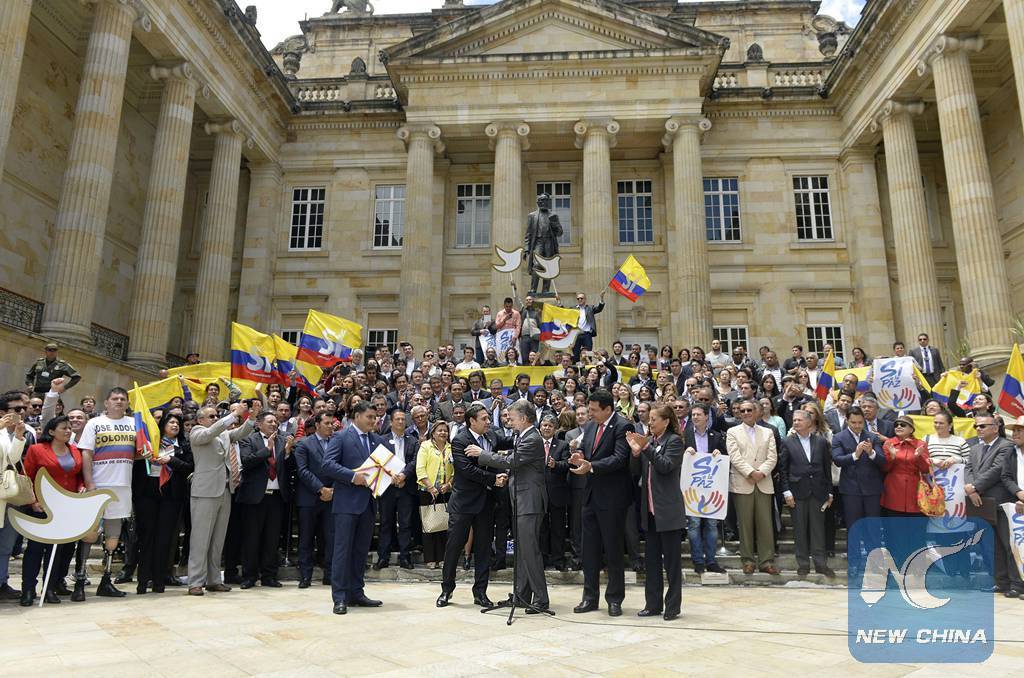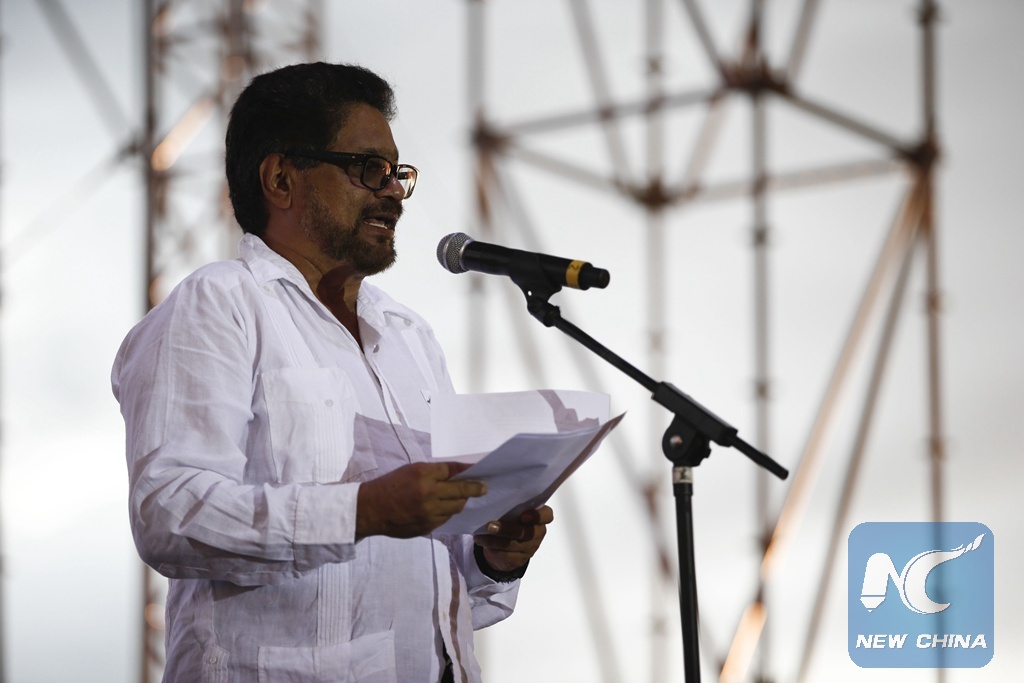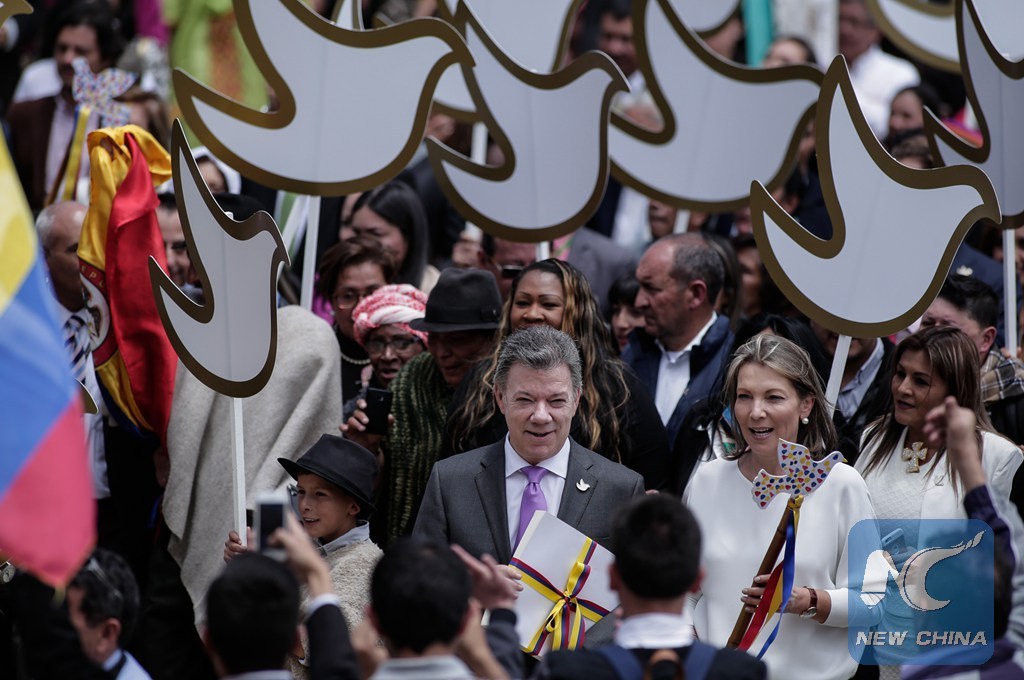
Photo provided by Colombian Presidency shows Colombian President Juan Manuel Santos (C) taking part in a ceremony to deliver to the Congress the peace agreement with the Revolutionary Armed Forces of Colombia (FARC), in Bogota Aug. 25, 2016. (Xinhua/Juan David Tena/Colombian Presidency)
by Chris Dalby, He Shan, Cesar Marino Garcia
BOGOTA, Sept. 25 (Xinhua) -- For many Revolutionary Armed Forces of Colombia (FARC) fighters, the 52-year war with Bogota seems like an eternity and the scars still run very deep.
"They shot me six times in the left arm. They tore me apart. My arm could not be rebuilt," David Preciado, a member of the FARC's 43rd Front, told Xinhua on the sidelines of the organization's tenth national guerrilla conference.
The oldest militia in the region now is longing for peace.
FARC leader Timoleon Jimenez told the conference that a victory of peace had been achieved after more than five decades of war.
"The meaning of a final agreement to end the conflict and build a stable and lasting peace is even more important than it appears ... For the FARC and our people, our greatest satisfaction is and will always be to have won peace," he said.
At the week-long conference that closed Friday, at least 1,500 FARC members invited from all fronts discussed and approved the peace agreement reached between the Colombian government and the FARC. President Juan Manuel Santos and Jimenez will sign the deal on Monday.
Ivan Marquez, a member of the FARC's commanding group, said Friday that "we inform the country, the governments and people of the world that the guerrillas, delegated to this conference, have given their unanimous backing to the final Havana agreement."

The chief negotiator of the Revolutionary Armed Forces of Colombia (FARC) Ivan Marquez addresses the closing session of its 10th National Guerrilla Conference in Llanos del Yari, Caqueta Department, Colombia, on Sept. 23, 2016. (Xinhua/Juan Paez/COLPRENSA)
Moreover, the conference is considered the most important ever for the FARC as it marked the beginning of drawing a political future for the organization.
Over the years, the FARC has been labelled a terrorist organization by the U.S. government, an enemy by successive Colombian governments and a defender by certain rural communities.
Today, the organization is on the cusp of gaining a new title -- a political party.
Marquez announced at the meeting that the FARC was expanding its central committee from 31 to 61 members, who face the challenge of outlining the manner in which the group will transform into a new political movement.
In a statement, the FARC said that another plenary meeting would be held to further define the political transition and the new name of the group. It will be held after the Oct. 2 plebiscite in which the Colombian people will vote on whether to accept or reject the peace deal.
A poll by Gallup Colombia carried out between Sept. 14-18 found that a majority of Colombians were in favor of the deal, with 67.6 percent planning to vote Yes.

Colombian President Juan Manuel Santos is seen at a ceremony during which he delivers the peace agreement with the Revolutionary Armed Forces of Colombia (FARC) to the congress in Bogota, Columbia, Aug. 25, 2016.(Xinhua/Jhon Paz)
However, should the peace agreement be approved by the Colombian people, FARC members will have to begin the transition to specific protection areas overseen by the United Nations (UN) where they will give up their weapons.
The FARC will have a period of 180 days to complete their disarmament. Once complete, the guns will be melted down and used as part of three monuments as a homage to peace.
Besides, this stage must include protection from the state against continuing paramilitary activity.
This point was a major topic during the meeting as the FARC hoped that continuing violence from right-wing groups would not disrupt the peace process.
For many guerrilla fighters, including Nicolas Garcias, the paramilitary groups are the main challenge for the peace process.
Garcias said 51 rural leaders have been assassinated in Colombia so far in 2016. He said investigations attributed the majority of these to paramilitary groups, who are against the return of lands as pledged by the government.
Despite these fears, many rank and file members of the FARC plan to integrate themselves into civil society and actively participate in politics, learning to juggle their continuing loyalty to the movement and their new social roles.
"I will do what the party says. I am not thinking of breaking with the party. We succeeded with them and we are ending with them. If the party tells me to go and sow yucca, bananas or maize, I will do it," Preciado, a guerrilla fighter who lost an arm in a fight with the military, told Xinhua.

